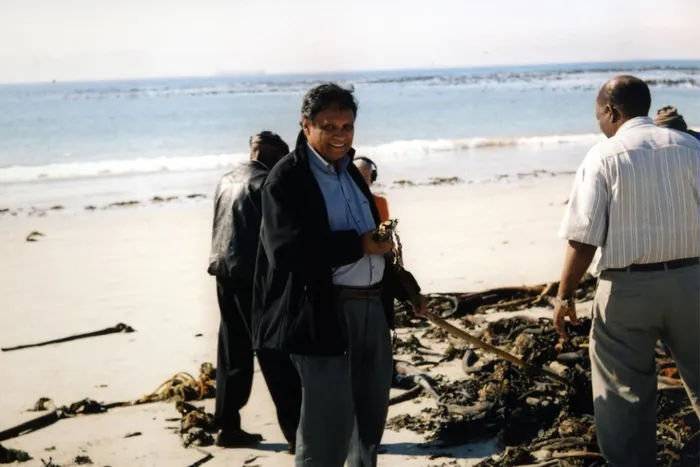The Folly of Forgetting

Ebrahim Ismail Ebrahim at a reunion of political prisoners on Robben Island in September 2005 who were part of the Bamboo span, who had to pull seaweed from the ocean. PHOTO: Supplied
I dedicate my final column as Group Foreign Editor to my late husband Ebrahim Ismail Ebrahim, who passed away two months ago.
Over the past weeks, I have spent hours reading through letters he wrote from Robben Island to his “political mother” Phyllis Naidoo that span from 1964 through to 1979, and then during his second incarceration from 1989 to 1991. He was one of the very few political prisoners to have been sentenced twice to that torturous prison colony.

His stories of deprivation and struggle have evoked a sense of urgency to ensure that our next generation understands the full extent of the suffering that our Struggle stalwarts endured. We cannot let the stories die, and places like Robben Island need to be supported as living museums, so that they do not meet the same fate as Liliesleaf, which recently saw its doors close due to a lack of funding.
A letter, dated 1977, talked about being part of a “span” that spent endless hours making mats out of old car tyres. That came years after the work in the bamboo span where they had to haul seaweed from the ocean, dry it on the shore and prepare it for export to be used in cosmetics.

But the years spent breaking stones in the quarry for eight hours at a stretch were the most painful – that constant monotonous clanging of the hammer against the stone, as the cold Cape wind numbed the bones and invaded their inadequate prison clothing. The letter read: “If I had a diary, I could fill many pages with the word ditto.”
The endless letters to the commander of the prison, asking for textbooks to be released so that he could continue with his studies, were heartbreaking. Each formal letter asked the prison authorities to reconsider their decision to withhold certain books as he couldn’t complete his year of studies without them. It had been a struggle to raise the R140 it cost to enrol for a year through Unisa, and the months of late-night study after exhausting hours in the stone quarry would have gone to waste. But the pleas were ignored, even after 14 letters of protest.
There was the constant struggle for reading material. And, for years, the only subscription they were allowed was to Farmers Weekly, and it would always provoke Harry Gwala to suggest they start a collective poultry farm when they got out of prison.

One of the most heartbreaking letters was from 1968, when he recounts having received a telex from his brother that his father, who was in his late fifties, had died. The prison authorities gave him the letter a day after his father had been buried – a typical attempt by the warders to break the prisoners’ spirits. On that occasion, they had succeeded.
There was the elation in 1977 that prisoners were finally allowed to use money in their prison account to buy small amounts of butter, sugar, jam and tea a month. But the issue was whether anyone from outside could send money for such extras when his family didn’t have money to spare, and Phyllis Naidoo was raising three children single handedly as her husband was also imprisoned on the Island.

In the early years, they were allowed to write only one letter every six months but, as the years went by, it became one letter every three months. Eventually, by the late 1970s, it was one a month. Then came the rule that extra letters could be written in lieu of visits, and given that Ebrahim rarely had visitors who could afford to make the journey from Durban, he was given an additional six letters he could write in 1978.
The letters written to Phyllis after his release when living under banning orders in Durban in 1979 exposed the harsh reality of trying to make ends meet. The authorities refused to relax the boundaries of the banning order to enable him to work in an accounting firm in town, leaving him surviving on irregular donations made from solidarity networks in Oslo or the UK, but it was never enough.
“To reduce the expense of newspapers I often go to the library to read them, and turn my lights off whenever possible to cut down on electricity. I minimise phone calls, and going to the cinema causes one to live beyond one’s means,” he wrote. After 15 years of deprivation, life outside was also a struggle to survive.
But despite all the hardship, he thrust himself back into the trenches of the Struggle, only to find himself once again in chains on the ferry being sent back to Robben Island exactly 10 years after his initial release, this time sentenced to a further 20 years.

His constant refrain throughout his life had always been that “revolutionaries never retire”.
Ebrahim’s legacy was his tireless determination to fight for a free and just South Africa, and it is now for us not to forget the sacrifices made by his generation.